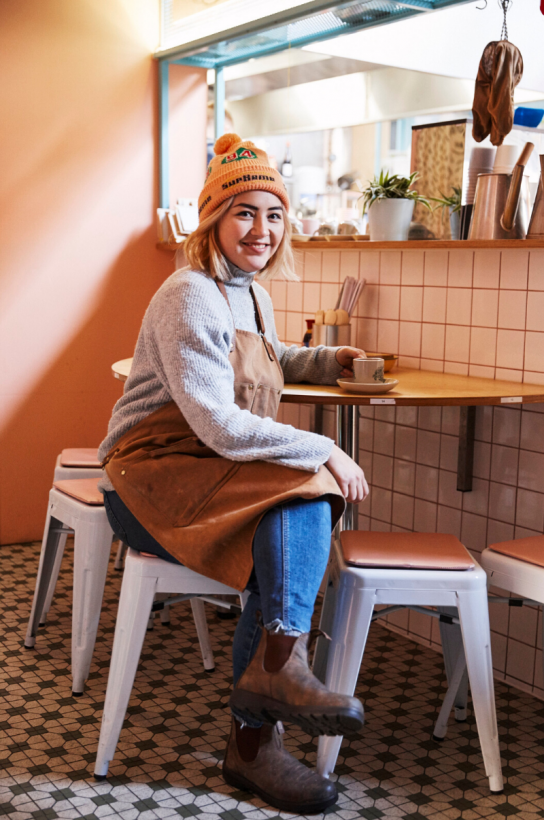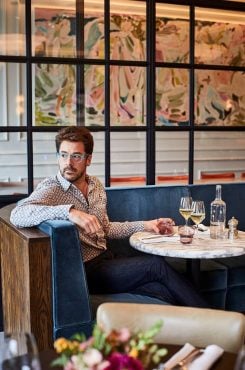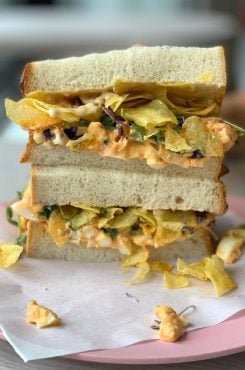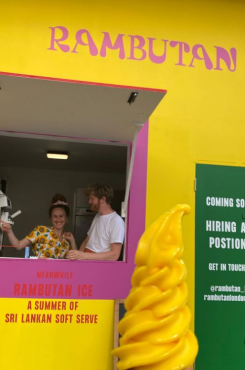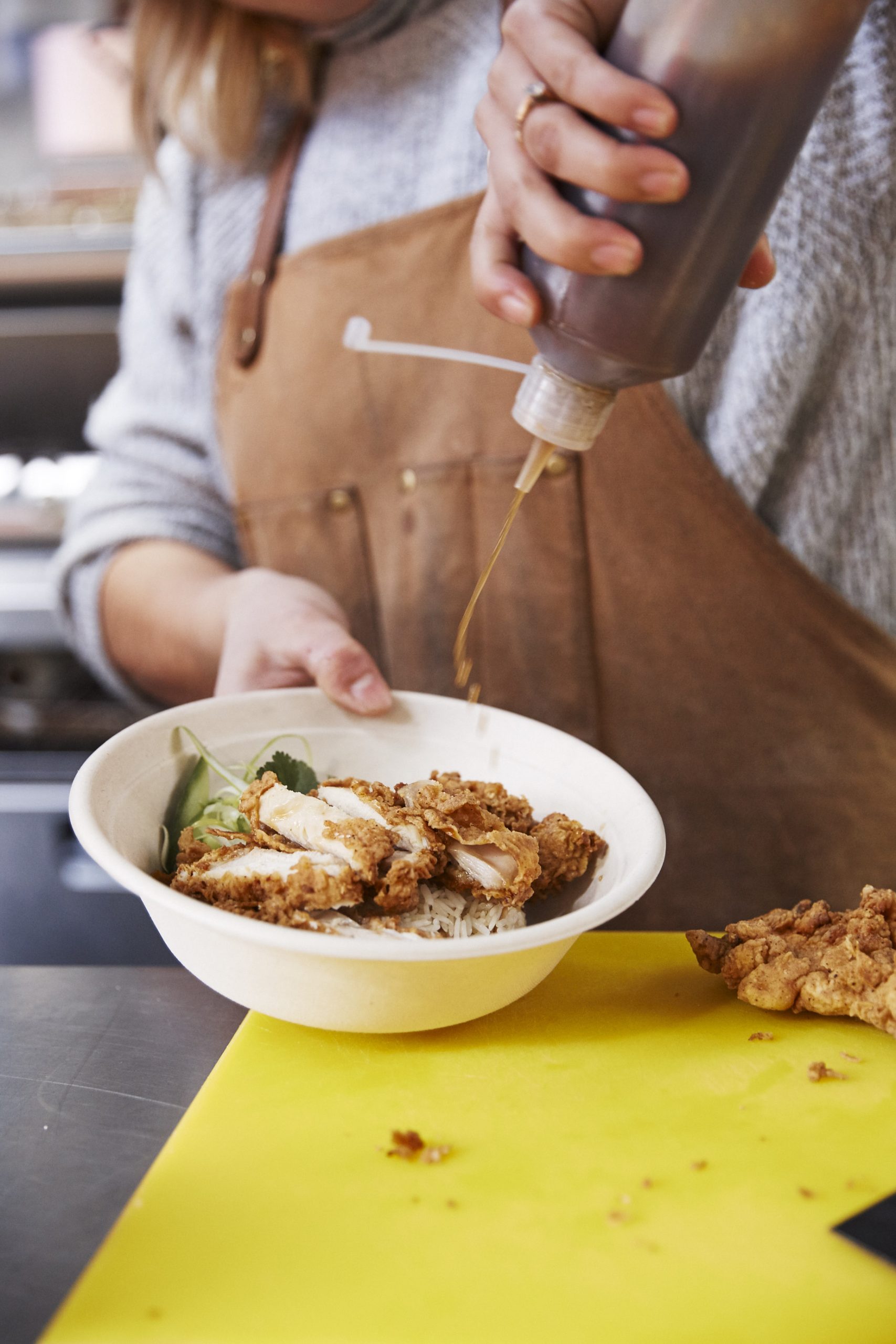
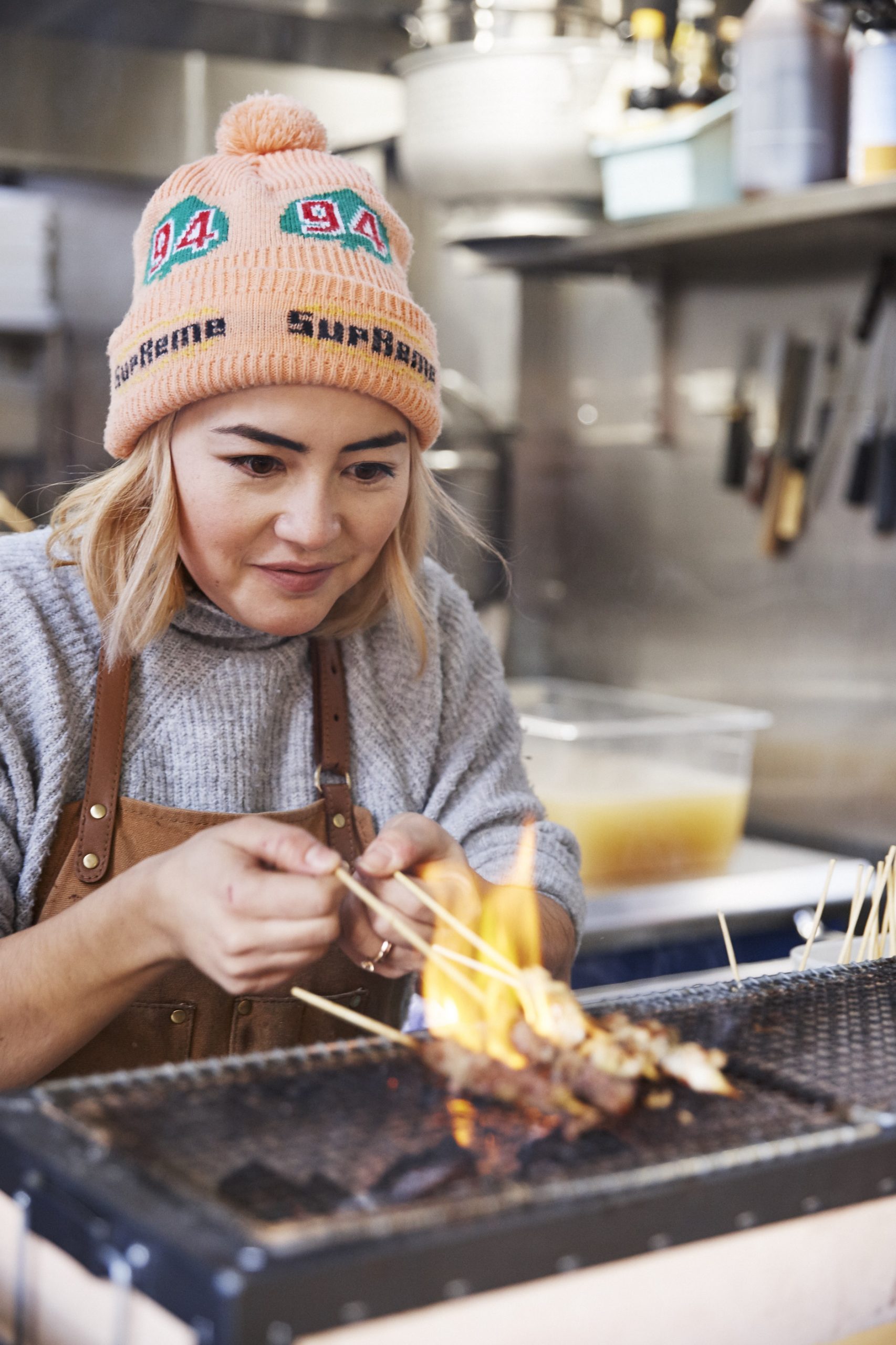
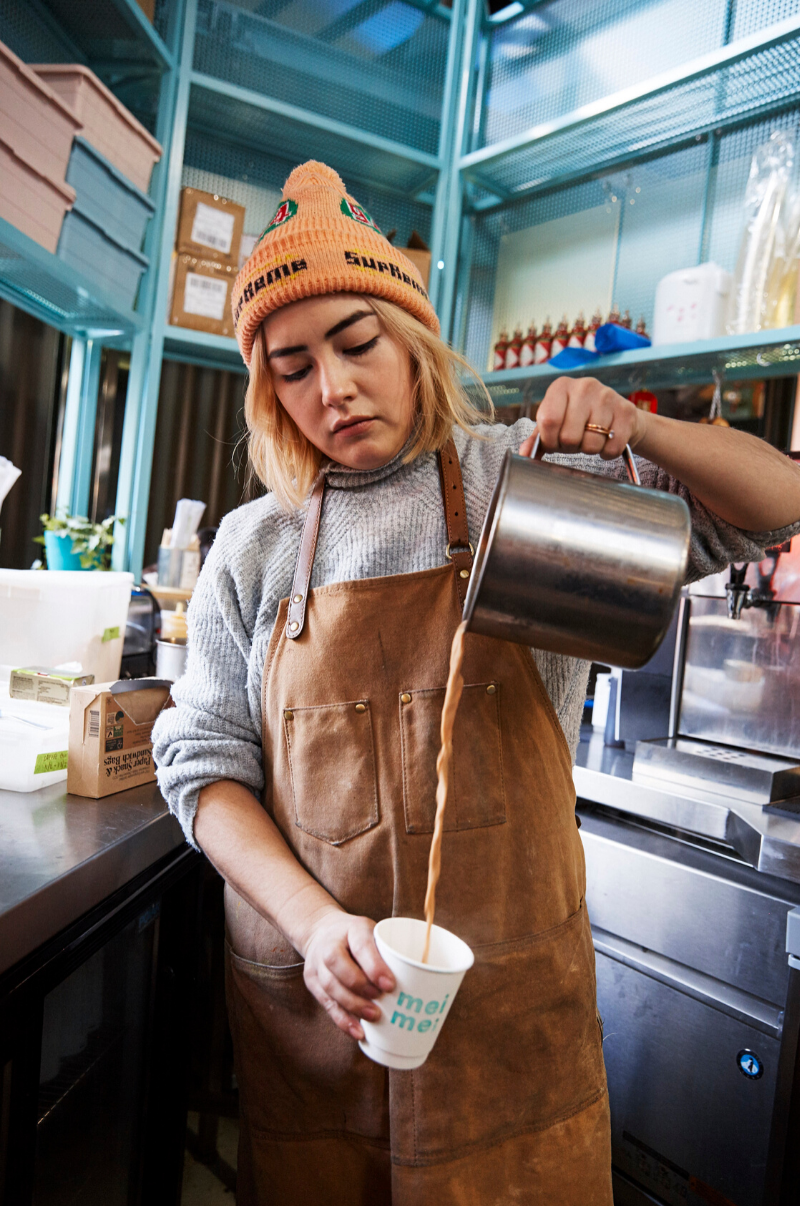
In this regular feature, we take a closer look at the workspace of people who inspire us. Here Elizabeth Haigh, chef patron of Mei Mei, talks about the structure, design and equipment that have brought her dream project to life. Photographs by Harriet Clare
Elizabeth Haigh launched her latest project, Mei Mei in Borough Market last November. Bustling and busy every lunchtime, it’s had rave reviews and has been a labour of love for the chef-patron, who has been working on her brand Kaizen House and another development project, Shibui, for some years – while also running pop-ups, guest appearances and juggling a young family.
The outside corner site in the new Borough Market Kitchen is carefully thought-out and structured to make the most of the space – a sign of Haigh’s past as an architecture student. It’s not without its challenges – trains trundle loudly overhead every few minutes, which is a noise and distraction both for the staff at the kitchen and the diners sitting at the triangular counter facing them. And the open-roofed outdoor space is chilly and the staff are all in wool hats and layers (although come summer, it will be gloriously airy and light).
How does Haigh make her thrillingly modern, yet respectfully Singaporean menu work? And how did she come up with the colour scheme, accessories and artwork that complete Mei Mei’s identity?
The concept
We were told about the Borough Market Kitchen development
in July – and when we first started looking at it, this was just concrete slabs. We worked day and night coming up with a presentation and concept pack… and this is all whilst we were doing a residency at Mortimer House. It wasn’t hard to come up with the concept, because it was something I knew a lot about, and wanted to do.
All the dishes are home comfort food, so it’s stuff I’ve
made at home a lot. The biggest challenge we faced was trying
to communicate that properly across. We pitched it and had
to do a blind tasting which I was super nervous about – they offered us the site straight away. Then we thought, right, now
we’ve got to raise the money for it and go through the process of starting up a company again.
There are so many things that no one teaches you as a chef about becoming a restaurateur that you’re not ready for. Luckily I had great mentors and support with that, but we had a bit of a rocky time with the fundraising.
In the meantime I was still organising everything with the suppliers and sourcing all the equipment, getting the design, branding and logos right- it was non-stop up to November when we opened and I was on site from 5am until late at night. My background is in architecture, so I was here every day with the builders. We got this place built and up in 18 days.
The space
The main challenge of the site is people knowing that we’re here – the market is so busy with lots of winding alleyways. Added to that, the space is really awkward, so we did so many sketches and I was able to play around with it – and the whole process of us getting and designing the site was really short, because we were one of the last few to be finalised!
I worked with B3 designers who are round the corner, so that was really useful; we just popped down and sketched something out. I always wanted an open-plan kitchen space because I think it’s fascinating seeing the process with the chicken from the exfoliating to the poaching and the cutting of it. I love sitting at a counter and watching kitchens.
It’s important that everyone in the team can communicate really easily, so if you close all of this off it would be impossible to do that. It’s just one giant kitchen here, so it was quite easy to design. However, the side area with its own table is really important. Originally the designers put two benches, but I needed a table where families could sit down, because the whole point is that we wanted people to be able to commune together and enjoy a meal together sitting down. Also, I can’t manage Riley [Haigh’s two-year-old son] on a bar stool for more than two seconds! A lot of people ask to reserve this table, which is impossible to do in Borough Market! It’s my favourite spot.
Tableware
All the melamine, crockery and even this tiling on the floor has come from China Town – I brought it back in my suitcase, it’s helpful having a baby’s luggage allowance as well as your own! The melamine is from Joo Chiat Road in Singapore, where one of my family members live and I really wanted to have that authentic look and feel. I love the ceramic cups and saucers from home too. Quite a lot has “gone missing” though, which is a real shame. It’s the same with the lovely Falcon enamelware too, the water cups are irresistible, it seems…
The menu
We alter the menus so that we can have a curry bowl that we’ll change around, because there’s so many curries I want to do, and also it keeps the chefs interested. When you constantly cook with chicken you get a little chicken stir crazy! What I love about being in Borough Market is that you can just pop and have a chat with producers about exactly what you want and you’re able to get it.
The chicken
One of the really important steps that people don’t realise about chicken and rice is the process. When you poach a chicken, you ice bath it first to basically shock and blanch it to get that really soft skin; then hanging it is like resting the meat and all the excess poaching liquid comes to it; then you brush it with the sesame oil to get that real soft, glistening and nice meat that’s rested properly. The biggest struggle we’ve had in terms of the product is people coming to terms with having cold meat, chicken particularly. That’s why I introduced the deep-fried version so you can choose a bit of both and it’s a lot more recognisable. I could eat the poached chicken every day, because it’s light and healthy, but it’s all about the little details that makes it special for me and my family – making sure you
use the right products, and the master stock you cook it in is well seasoned.
It breaks my heart every time I read a Google review where they say the chicken is bland – we’re having to educate people about this dish. It’s about the sauces that go with it. You’ve got to have the zingy chili garlic sauce that’s got lots of lime juice and fresh chillis. The sweet or dark soya sauce, too. You’ve got to mix it all in, but if people don’t know how to eat that and just have the chicken on its own, for some people it might be bland. But, it’s all about how delicate it is and for me that’s what makes it special. I do get it if people don’t understand it, I think we’ll just have to do more videos and education on it.
The ingredients
I would never say my food is authentic Singaporean, because we’re not using ingredients from Singapore. But what is authentic anymore? This is why we put a lot of effort into bringing bits of Singapore here and doing things the right way, but also adapting to the ingredients and equipment we’ve got. Pandan, which is the key ingredient for the Hainanese chicken rice, has to be imported.
There’s a lot of Singaporean and Asian restaurants doing great things in London, but we’re just trying to do our bit for the culture. People are happy we’re doing chicken rice because it’s a favourite for a lot of people. I find most places skip too many steps in the dish.
We use fragrant Thai jasmine rice because I like the flavouring (it uses pandan, which matches the chicken). We use the master stock from cooking the chickens to make the rice, rather than water, to get more of that chicken flavour. We basically use every part of the chicken – all the carcases go in to make a more avourful stock and the skins and anything left over gets rendered down – we cook rice in that fat with ginger and garlic and pandan. You can’t miss out any of those steps.
The drinks
My coffee and tea actually come from Singapore, because the way they make the coffee is very unique – a mixture of arabica, liberica and robusta beans – and they roast it longer than here and pour caramel and margarine into it, and basically caramelise the beans and then they grind it in an expensive coffee machine.
We use these tins which we bought back from Singapore, and then the coffee resembles thick black tar; its sweetened with condensed milk, because we don’t have fresh milk in Singapore. It’s my favourite way of having coffee!
The tea is tea dust, and again we put that through these ‘socks’ and it’s really intense, but when you combine that with the condensed milk it’s almost like having a Rich Tea biscuit dunked in tea. The whole process of the tea comes from the Indians that migrated to the Straits in Singapore and the technique of the pulling is from the Indians, who did the chai and the frothing. The frothing of it makes it lighter and a lot less intense. So we try and do everything how Uncle would back home!
I’ve kept the traditional translation of the way we do tea and coffee the same, so kopi being condensed milk and black co ee, and kopi o means without milk for example. I love that the whole team have learnt that lingo and all the people who know of kopi and are from Singapore or South-East Asia get so happy when they ask for black coffee without sugar- I say it in the translation and they gasp.
The customers
I’ve really enjoyed doing this. It’s part of the community here and that’s exactly what I wanted the first step of Mei Mei’s brand to be. We’ve had a lot of struggles, and the first few months were really tough, because it’s a completely new area.
I understand now why people have anxiety when they open restaurants because it is tough – but I couldn’t be happier doing it. It’s really fun to teach the guys something new and have a di erent audience than I’m used to. Every customer that comes here is completely new.
We also have incredible regulars – there’s one guy that comes for our signature butter co ee or kaya toast (kaya is a rich coconut jam and my version has salted caramel in) every morning and I love that.
I get to chat with everyone who comes to the counter because I’m here every day, which is really important for sta and customers. In summer we’ll have cocktails, have the BBQ sh on and satays.
The future
The plan is to roll Mei Mei out. Without compromising on quality, I want to make sure that every nook and cranny has
a kopi tiam (coffee shop). I want everyone to know what kopi means and what the lingo means.
It would be really great if everyone had respect for different culture and coffee culture – outside of Singapore that doesn’t really exist, and it would be great if we could represent the rst one in London.
I’d love to have an afterhours Mei Mei spot where we can do the full BBQ and evening service. It’s definitely going to be the rst of many. I’m proud of us.
This article was first published in Issue 22 of the CODE Quarterly magazine. To read the digital version, please click here
